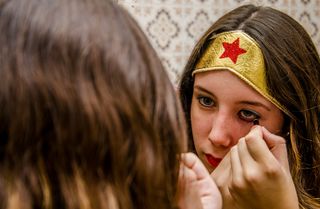Eating Disorders
Four Messages We Wished We Got from the New Wonder Woman
Why the new Wonder Woman film didn't fulfill our feminist expectations
Posted July 5, 2017

Two body image experts walk into the movie Wonder Woman. This isn’t the beginning of a joke but the experiences of Alexis Conason and Jenna Hollenstein, a psychologist and a registered dietitian, both of whom work with people with disordered eating, eating disorders, and body image disturbances. After a particularly trying week of fighting diet culture, we figured it would be good for morale to watch a woman save the world. Was it? Yes and no.
Gal Gadot was really good. She was earnest and sincere. She cast believably compassionate looks at suffering innocents, seriously committed to the role she was playing, and kicked ass. All of this while filming many of the scenes pregnant. If that’s not inspiring, we’re not sure what is. We felt empowered watching a strong female lead guided by a female director breaking many stereotypes about what a woman can and cannot do. It was certainly a welcome change from the male hero saving the damsel in distress. But as the only female superhero for this new millennium, the film fell short for us.
We read the many reviews praising the film as a feminist manifesto of our time, but we didn’t feel satisfied. Calling the film a feminist triumph feels like settling for moving up a floor in a building inevitably sealed with a glass ceiling. We are praising Hollywood for taking some risks from the safe confines of the patriarchal framework, without really risking anything, especially alienating their core male adolescent audience. Call us brazen, but this is not good enough for us.
Is it wrong to want more? Are we allowed to want more? In the words of the fat activist and total badass, Virgie Tovar, “We don't want a slice of the existing pie, we want a whole new pie.” And because Wonder Woman - and we - deserve better, here are four messages we wish we had gotten from the new film:
1.) You don't need to fit the narrow stereotype of female beauty to carry a leading role.
In terms of casting, the film played into tired old female stereotypes by casting a hot, thin, young, white and apparently straight cis woman for the lead, while the only fat woman was a matronly, comedic, and desexualized secretary and evil was personified by a petite, brainy woman with a facial disfigurement.
This was a real opportunity for Hollywood to go beyond these stereotypes, to cast a Wonder Woman with something other than the so-called ideal female body type, which coincidentally is thinner than 99.9% of women. To take down opponent after opponent, one might actually benefit from a little brawn, some obvious muscle mass, a larger stature, even a few battle scars. While still very limited, there are more actresses with different body types in Hollywood than ever before – think Viola Davis, Lucy Lawless, Gina Carano, Melissa McCarthy, Michelle Rodriguez, and what we would have paid to see Serena Williams (assuming she can act) in this role, to name a few.
We’re not saying that thin women can't be strong and fierce; in fact many are. And Gadot certainly trained intensely for her role in the film, reportedly adding seven pounds of muscle mass onto her lithe frame. But we see thin women everywhere, in nearly every role, and get messages from every direction that thin bodies are the only good bodies. As eating disorder professionals, we see first hand the fallout from this and the torment that women go through in pursuit of the mostly unattainable bodies we see onscreen.
The film could have also taken more risks with Wonder Woman’s sexuality. DC Comics already brought Wonder Woman out of the closet, confirming her bisexual orientation in a 2016 interview. But the film instead portrayed the island of Amazons as female eunuch fitness models in waiting. Are you telling me that after all those sweaty battle-training sessions, none of these gorgeous ladies got down with their Sapphic selves? In an emerging era of gender fluidity and greater acceptance of different sexual orientations and gender identities, again, this seems a missed opportunity. To portray a powerful woman as being powerfully confident and in charge of her sexuality had the potential to be a family-friendly message even for the PG-13 audience.
And while we are at it, wouldn’t an Amazon woman be brown-skinned? There were hardly any women of color represented in the film. Was Gadot really the most qualified, or did the producers just not want to risk alienating their core audience of male adolescents who came to check out Wonder Woman's breast-plated rack?
2.) Your body doesn’t need to be perfect to be a wonder.
Besides being young, thin, white, cis, and heteronormative, the body of Gal Gadot was represented as damn near perfect. From the perfectly tousled blowout, to the absence of unruly body hair in this otherwise dark-featured princess, to the balletic bodily movements when getting down and dirty like saving someone from drowning and landing a perfect flying kick, every move catered to our critical gaze. Not that we didn’t love to see a little thigh jiggle happening when Wonder Woman landed firmly from flight. But consider what it would have been like to see a less than perfect figure heralded as the epitome of power and righteousness.
3.) Our only female superhero doesn’t tolerate objectification.
Perhaps in an attempt to lure male audiences into a film that might otherwise be threatening, Wonder Woman is portrayed as a sex object. She kicks ass in a corset without sweating, bleeding, messing up her blowout (see our issue with perfection above), or anything else that could be a turn-off. The male characters ogle her and even grab her to dance without her permission. But despite her enormous physical strength and zeal to fight for justice in the world, Wonder Woman doesn't bat an eye at her own objectification. It's as if she is saying, “Go ahead, sneak a peek, cop a feel, make a sexist joke, it's a small price to pay for sharing the world with above-average men. Besides, what else am I here for if not your viewing pleasure?” Oh yeah, to save the world.
We totally appreciate that this was one of the rare female-directed superhero (or any) films, and that the typical slow-mo body pans were absent…Yay! But still, it’s as if the director internalized the expectations of the male gaze (like many of us) and failed to depart from such predictable sexual politics thanks to our collective programming. We know this new version was meant to be set in the 1940s but its sexism didn’t have to be. Even Linda Carter’s late-70s Wonder Woman took some ogling asses to task (or is that just our recovered memories speaking?).
4.) You don't need a man's love to reach your full potential.
Born into a world without men, Wonder Woman literally falls for the first man she lays eyes on and quickly becomes dependent on him and three of his unruly pals to bring her to Ares, the evil god of war. She's freaking Wonder Woman! Why can't she find her own damn way to the evil god? Even once it becomes obvious that these guys are pretty useless to her - they really just slow her down and tell her all the things that she can't do (hmm...that sounds familiar) - we are told that it's LOVE that is the secret to Wonder Woman's power. You heard right, only after Steve professes his love does she unlock her full potential and open up that ultimate can of whoop ass. She needs a man’s true love in order to save the world from evil. She can't do it without a man. Gag.
“You are stronger than you believe. You have greater powers than you know.” This was one of our favorite quotes from the film, a premonitory plea made to Diana by her aunt Antiope (played by Robin Wright) as she prepares to leave the safety of her women-only utopia and enter the dangerous world of men. We believe this sentiment holds true for all of us, though this power is less likely to manifest itself in roundhouse kicks and bullet-repelling wristbands, and more likely to materialize in the much more powerful tools of speech, compassion, and activism.
But in order to reach this potential, we must move beyond the limited boundaries imposed by our cultural conditioning. Easier said than done. Just as the new Wonder Woman film took some risks within the confines of the existing patriarchy, women are given the message to push the boundaries, but not too far at the risk of being troublesome, too pushy, and above their pay grade. That this powerful and extremely visible role was portrayed by a woman who fits the narrow female ideal only served to remind us of this bind.
Just imagine how much more quickly we might realize our power if we also realized our body was equally capable and wise. As we push the limits of what we see portrayed on the screen we will gain strength to push our own limits and challenge preconceived notions of what we can and can’t do. Like Wonder Woman, we believe that it’s love that will ultimately save the world. But it will have to begin with loving ourselves just as we are.
Dr. Alexis Conason is a clinical psychologist specializing in the treatment of overeating disorders, body image dissatisfaction, and sexual issues. She is the founder of The Anti-Diet Plan. Sign up for her free The Anti-Diet Plan 30-day starter course today. Follow her on Twitter and like her on Facebook.
Jenna Hollenstein, MS, RDN, CDN, is a non-diet dietitian and meditation guide who helps people struggling with chronic dieting, disordered eating, and eating disorders. She uses a combination of Intuitive Eating, mindfulness techniques, and meditation to help her clients move toward greater peace, health, and wellness. Sign up to receive her free guide to conquering emotional overeating. Jenna is the author of Understanding Dietary Supplements, a handy guide to the evaluation and use of vitamins, minerals, herbs, and botanicals for both consumers and clinicians, and more recently the memoir Drinking to Distraction. Follow her on twitter and like her on Facebook




